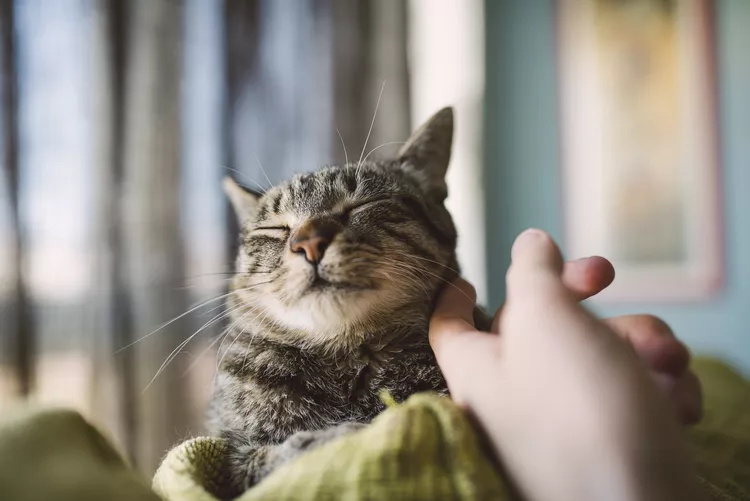7 Places Where Cats Like to Be Pet

If you love cats, then you probably enjoy petting them. Many cats love to be pet and will seek it out. Others are reluctant to be touched at all. Most cats enjoy some petting as long as it's on their own terms. Although no two cats are exactly alike, there are certain areas cats like and dislike being pet. A cat's desire for petting depends on the cat's, history, personality, and relationship with you.
Why Cats Like To Be Pet
There are a few reasons why many cats enjoy petting from people. Cats often communicate with one another by rubbing, nuzzling, and grooming to transmit scents and pheromones. They may use the same behaviors to communicate with humans. These are often signs of love and affection. By petting a cat, you are communicating love back to the cat.
Kittens are nurtured by their mothers via grooming and nuzzling. These actions cause a rise in oxytocin, also called the love hormone. Oxytocin also increases in humans and cats during affectionate interactions.
Many cats enjoy being pet because it feels good. Other cats resist petting because it feels uncomfortable or unfamiliar. Cats may dislike petting due to personal preference. It may also be related to fear, pain, or lack of socialization.
In general, cats are more likely to enjoy being pet by humans they trust and less likely to accept petting from strangers.
How to Pet a Cat
It may seem simple, but the last thing you should do is jump right in and start petting a cat without first assessing the situation. If you want to pet a cat, start slowly and watch the cat's reaction.
- If it's not your cat, ask the owner first if it's okay to pet the cat. Cats are often distrustful of strangers and may respond with fear or aggression.
- Ask the owner if the cat has sensitive or painful areas that you should avoid. Ask if the cat has specific ways they like to be pet.
- Allow the cat to approach you first. If you go after the cat, you may lose the opportunity to gain their trust.
- Slowly hold your hand out in a relaxed position, but do not put it close to the cat's face.
- Allow the cat to smell your hand and "explore" you. The cat may rub on your hand or legs.
- Begin to gently pet the cat on the sides of their face.
- Let the cat guide you. They may rub against you with more pressure and even direct your hand to other parts of their body.
- Stop petting the cat if you notice tension in their body or you hear a high-pitched meow, hiss, or growl.
Once you have established a relationship with the cat, you may wish to try petting them in other areas. Many cats enjoy petting from trusted people in the following areas:
- Sides of the face
- Top of the head
- Neck
- Under the chin
- Along the sides of the body
- On the shoulders
- Along the back towards the tail
If the cat is enjoying the petting, they may begin to purr, knead, and even drool. Be aware that petting in some of these areas can make a cat feel good one moment, then vulnerable or overstimulated the next. Some cats will suddenly meow, hiss, growl, scratch, or bite while being pet. This is called overstimulation aggression or petting-induced aggression.
If the cat is feeling affectionate, they may roll on their side and expose their belly. This may be a sign that the cat is relaxed and comfortable. It is usually not an invitation to touch their belly. However, there are some cats that genuinely enjoy having their bellies rubbed. If it's your cat, you may wish to try and pet them there, but proceed with caution.
Some cats enjoy gentle scratching, especially if you have long fingernails. This another action you should start slowly and gauge the cat's response.
Areas to Avoid
When petting cats, it's important to steer clear of "private" areas like the anus and genitals. It is uncomfortable for cats and may end in a cat bite. Don't pet these areas, even if your cat presents their rear end to you.
Preferences will vary from cat to cat, but there are a few areas that are best left untouched. There are always exceptions, but most cats do not want to be touched in the following areas:
- Belly
- Feet and legs
- Thighs
- Tail, especially the underside
It's also a good idea to avoid hugging or picking up cats unless you are close to the cat and you know they enjoy it. You may find that your own cat enjoys things that other cats don't like. Don't assume other cats like that same treatment as your own.
Signs a Cat Does Not Want To Be Pet
Cats use various signals to communicate with people. While petting a cat, you may be able to see that the cat wants you to stop if you know what to look for. Do not try to pet a cat if they react in one or more of the following ways:
- Arching the back or moving away from your hand
- Flattened ears
- Narrowed eyes
- A tail that is swishing, puffed up with fur, or rigid and held high
- Vocalization like hissing, crying, high-pitched meowing, and growling
- Running away
- Hiding
If you notice any of these behaviors, simply leave the cat alone. They may come back to you later once things calm down.